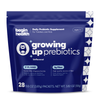Eat More Of These 5 Gut Friendly Foods
share this article

Gut-Friendly Foods For Kids
Many people believe that our gut has one sole purpose: processing food. However, that is only partly true! Research says that a healthy gut can influence the brain including cognition, thinking skills, and memory. The gut is referred to as the “second brain” for a reason! It is also very important for immune system health – about 70% of the immune system is housed in the gut.
We all know that fiber and fluid are both vital for gut health. But, many other foods can support gut health – just in a different way. Here are five gut-friendly foods for kids that you can offer to support brain health and overall health!
Polyphenols – Think Deep Red and Purple Foods
Let’s start with polyphenols. Polyphenols are a type of chemical compound that comes from plants and helps to keep bacteria balanced. Foods that are commonly high in polyphenols are typically deep red and purple-colored foods. These foods include elderberries, blueberries, pomegranates, blackcurrants, cherries, strawberries, plums, raspberries, dark chocolate, hazelnuts, herbs, spices, and red wine (for mom and dad). Research has found that polyphenols are beneficial for our health because they can help to promote a healthy immune system and reduce inflammation in the gut. Polyphenols also reduce the risk of chronic diseases such as cancer by protecting cells from damage caused by oxidative stress – similar to the way antioxidants work!
Polyphenols are also used to “feed” beneficial types of bacteria. Akkermansia muciniphila is one of many types of bacteria in our gut. High levels are beneficial for gut health and support gut lining. Low Akkermansia levels are linked to several digestive disorders including Crohn’s disease, ulcerative colitis, and appendicitis. The “muciniphila” part of Akkermansia literally means “mucous-loving” – and it does! It supports the mucous lining of our gut walls and makes them stronger. In order to have a stronger gut lining, it is important to feed Akkermansia with its favorite food – polyphenols!
Fermented Foods
Fermented foods are beneficial because they contain live culture probiotics and can help with digestion. The process of fermentation breaks down nutrients in food so that they are easier to digest. Eating fermented foods can also help with digestion and decrease constipation.
Some fermented foods that your kiddo might like include yogurt, pickles, kombucha, or the “drinkable yogurt” – kefir. If they are feeling adventurous or like big flavors, you can also offer kimchi or sauerkraut. Want more ideas? Check out my round up of fermented foods kids love.
Apples and Pectin
Next, how about apples! Apples contain pectin which is a helpful prebiotic and soluble, fermentable fiber. Pectin can reduce colonic transit time and decrease constipation. Pectin is also in plums, gooseberries, cherries, apricots, carrots, and quince fruit. Additionally, Lactobacillus species, a common probiotic, is found in the skin of organic apples. If your kid doesn’t like eating the skin, try making an apple sauce. They won’t know it’s there.
It turns out; an apple a day really does have health benefits!
Resistant Starches and Cooking Science
Resistant starches are carbohydrates that have a “stronger” chain of glucose that is not digested in the gut, and therefore “resistant” to digestion. In this case, that is a very good thing! This is helpful for gut health because it increases butyrate production, which is a food source for many of the beneficial bacteria in our gut. There are many different types of resistant starches. For our purpose today, let’s talk about resistant starches that kiddos may accept!
One common way of serving resistant starches is offering cooked and cooled carbohydrates. Cooling these foods turns them into resistant starches via a process called retrogradation. For example, when you cook and cool pasta, the carbohydrate chains become stronger. The same thing happens with rice, potatoes, corn, beans, and oats. Some examples of resistant starches you could feed your kiddos would be sushi rice, potato salad, corn tortillas, and even oatmeal cookies.
Daily reads to help your little ones lead happier and healthier lives.
Join the
Happy Gut Club
Prebiotics
Last, let’s talk about prebiotics. Prebiotics are carbohydrate-based dietary fibers that act as a food source for probiotics, which enables them to grow and colonize the gut. They are in foods like garlic, onion, barley, leeks, asparagus, oats, bananas, apples, and yams. Learn more about prebiotics here.
If your kiddo is not eating a significant amount of those foods on a regular basis, you can supplement with a prebiotic powder like Begin!
Summary
Eat more gut-friendly foods that kids love. This will lead to a more diverse microbiome, which can help support brain and immune system health.
















